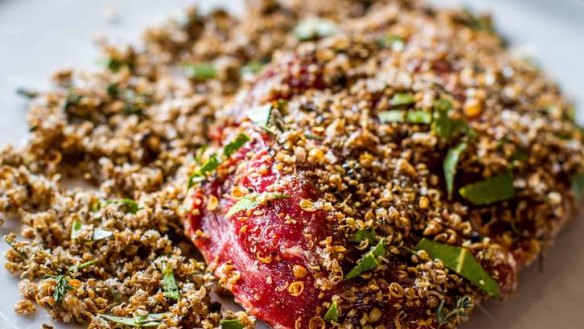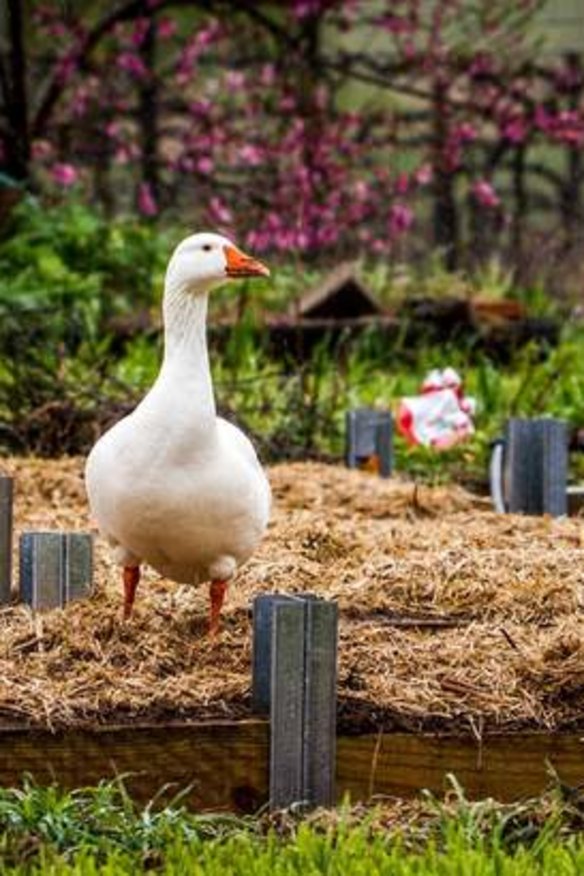Murder most fowl

In life - particularly married life - you sometimes find yourself in awkward situations. Some are easy to explain away - ''Oops, sorry, got caught up with the lads. How was your weekend?'' - but others, well, nothing you say is going to really explain them.
My wife is used to a lot, I have to admit, and seems to just take it in and shrug. I'm sure she's thinking, 'Well, there are worse things he could be doing.' But just recently, she found me in the paddock on a warm spring day, perched over a prostrate goose, its huge white wings spread angelically wide. To all appearances, I was kissing it.
It's the silent moments that worry you the most. It's so much easier to react to laughter, rage or tears, but dead silence is the worry. All I heard was the afternoon wind blowing gently through the blue gums. Above a crow cawed and, distantly, an alpaca giggled.

I should point out that this was an emergency, and I wasn't just thinking about how weird it looked.
At work, we keep up to date on all aspects of first-aid training, spending considerable time assessing possible dangers in the workplace and what to do in an accident. We're all certified first-aiders and have spent a lot of time trying to revive rubberised dummies.
So when I find a goose floating in the dam, my training kicks in. First, get it away from danger - that being the two now very angry male geese who must have drowned the female trying to have their way with her. I was aware of lots of splashing just a few minutes earlier and noticed that they seemed frisky, so I know there is still time to bring her back. I check her airways and begin mouth-to-beak resuscitation. In the back of my mind, I know this was desperate stuff as it's impossible to get a good seal with a beak and they don't make this type of mask.
When my wife turns up, my first thought is to ask her to rush to work, where we have a new defibrillator. But now over her stunned silence, she is laughing uncontrollably.
I know it might seem funny, but what if it had worked? Wouldn't I now be a hero rather than the pariah I feel heading back to the house to put a big pot of water on the boil, find some mouthwash and sharpen my knife?
The pair of ganders stand by, looking for the world like football players after a night that got completely out of control.
So, what to do? Should there be a burial or should I turn a difficult time for everyone concerned into a positive and prep her for the pot? It's not often you get the chance to consume dead pets, and it would be a shame to let this one go by.
Changing hats from first respondent to cook, I look at the goose in an entirely different light. The first thing that needs to happen is for the feathers to be removed. There's a bush calculation that you need two cups of boiling water to one cup of cold water to get the right temperature so you can remove the feathers with relative ease. This turns out to be about 80 degrees Celsius so I fill a large tub with water and immerse the goose in it. Now it's just a matter of quickly pulling feathers out. The bigger feathers are fairly easy, but being the end of winter, there is heaps of down, which is hard to wet so requires lots of elbow grease and turning of the carcass. After about an hour, I have a denuded goose - and potentially a new pillow.
Next up, we gut it and trim away the wings, head and feet. My dog stands close at my feet, wishing to renew our friendship and get a few scraps.
This is a big goose - she was about three years old, which puts her way past the roasting age - so I come up with a plan to turn the very thick, very dark, breasts into air-dried goose ham and prep the legs and wings for confit to use in a cassoulet.
How are we all doing? I really need to charge on here and not think too much about what I'm up to. I mean, it's not like I'm prepping the family cat for the pot. This goose had a very good life, living on our dam and around the farm. I can't say I'm that impressed with what the pair of males just did, but they have inadvertently opened a door to their own possible fate.
Confit goose legs
2 goose legs, or 4 duck legs
1 bunch thyme
1 head garlic
rind from one orange
1-2L goose fat
Cure
10g whole coriander seeds
1 star anise
50g pink salt flakes or similar
5g (about 1 tsp) juniperberries
10g black peppercorns
leaves of ½ bunch thyme, plus extra
5 bay leaves, shredded
Make the cure as for the ham recipe. Rub the legs with the cure and leave overnight or for up to 12 hours.
Rinse off and place in a deep roasting tray with the thyme, garlic and orange rind. Heat the fat to about 100C and pour over the legs - they need to be totally submerged. Cover with a lid or foil.
Place in an oven set at 75C and bake for 24 hours. The meat needs to be well cooked and soft - check at the halfway point, an old goose like this takes some cooking. If you are using a young goose, the time will be about half this.
Cool a little, then remove the legs and place in a sterile preserving jar. Strain the fat and pour over the legs to cover completely. Chill quickly and store for use.
Confit goose or duck is good for cassoulet, or you can just serve it with a salad.
Goose ham
2 x 800g fresh goose breasts
Cure
25g whole coriander seeds
2 star anise
100g pink salt flakes or similar
10g juniper berries
25g black peppercorns
leaves of 1 bunch thyme
10 bay leaves, shredded
Dry roast the coriander seeds and star anise until fragrant. Grind them and the other spices to a coarse powder. Mix in the salt and herbs. In a crockery dish, spread one-third of the cure in a layer, place the breast on top, skin-side up, and cover with the remaining cure.
Cover with cling film and allow to cure for 48 hours in the fridge.
Rinse off the excess cure mix, wrap in muslin and hang somewhere cool for about seven to 10 days (mine is on the shady back verandah, but a cellar would be ideal), until it feels firm but not dried out.
Once ready, you can use this in salads all through summer.
>> Bryan Martin is winemaker at Ravensworth and Clonakilla, bryanmartin.com.au.
Restaurant reviews, news and the hottest openings served to your inbox.
Sign up